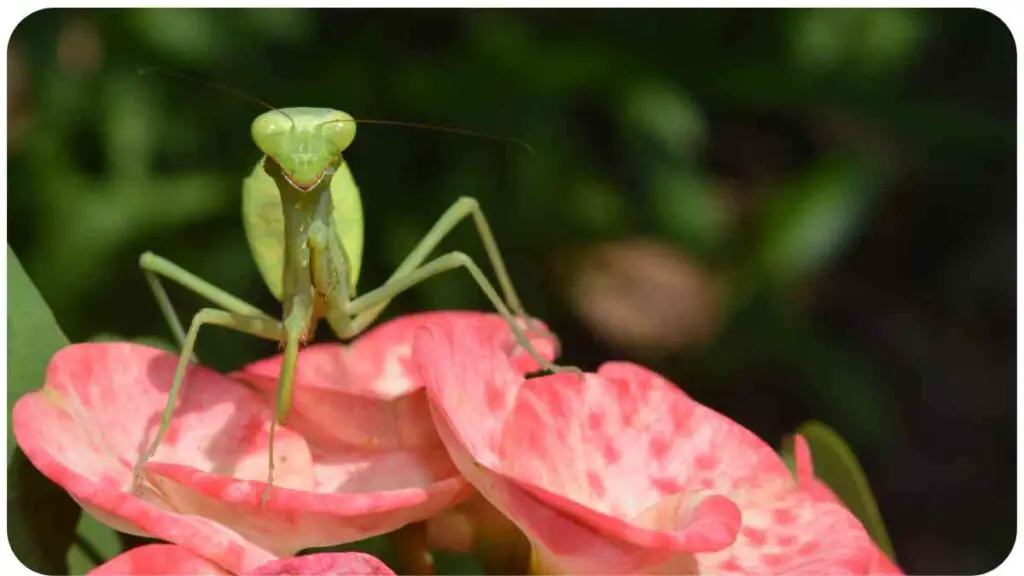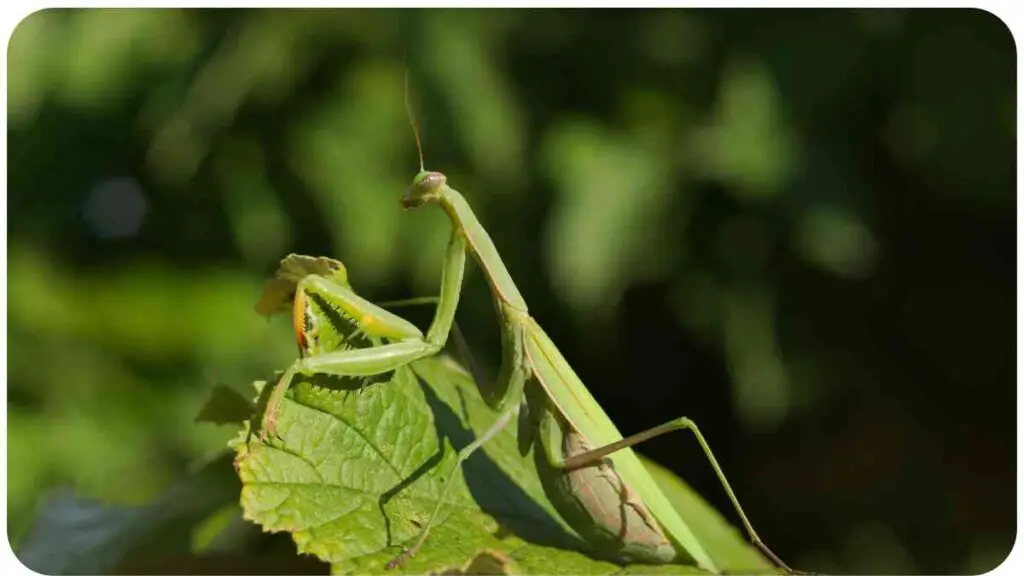Are you looking for a natural way to control pests in your indoor garden? Praying mantises might just be the solution you’ve been searching for! These fascinating insects are not only intriguing to observe but can also serve as effective predators, keeping unwanted pests at bay.
In this article, we’ll explore whether praying mantises are good for indoor plants and how you can harness their benefits to create a healthier environment for your greenery.
| Key Takeaways |
|---|
| Praying mantises can serve as natural pest controllers in indoor gardens, preying on common pests. |
| Introducing praying mantises to your indoor garden requires careful consideration of environmental factors and potential challenges. |
| Maintaining a suitable habitat for praying mantises, including temperature, humidity, and food sources, is essential for their effectiveness. |
| While praying mantises are generally safe for humans and pets, they may prey on beneficial insects if prey is scarce. |
| Further research and consideration are necessary before deciding to introduce praying mantises to your indoor garden. |
2. The Benefits of Praying Mantis for Indoor Plants

Praying mantises offer a range of benefits when it comes to protecting indoor plants from pests. Let’s take a closer look at how these remarkable insects can positively impact your indoor garden:
Preventing root rot is crucial for maintaining healthy indoor plants. By following proper preventive measures, such as regulating watering and ensuring proper drainage, you can safeguard your plants’ root systems and promote their overall well-being.
Table: Comparison of Praying Mantis Benefits
| Benefit | Description |
|---|---|
| Natural Pest Control | Praying mantises are voracious predators, feeding on a variety of pests such as aphids, flies, and caterpillars. |
| Non-Toxic Solution | Unlike chemical pesticides, praying mantises pose no harm to humans, pets, or plants, making them an eco-friendly option. |
| Sustainable Pest Management | Once introduced, praying mantises can establish a self-sustaining population, providing long-term pest control benefits. |
Praying mantises can effectively control pests in your indoor garden without the need for harmful chemicals, making them an environmentally friendly choice.
3. Understanding the Praying Mantis Lifecycle
Before diving into how praying mantises can benefit your indoor plants, it’s essential to understand their lifecycle. These fascinating insects undergo several stages of development, each with its own unique characteristics and behaviors.
Choosing the right spray for your indoor plants is essential for their health. Explore a comprehensive guide to understand the different options available and how they can address common issues like pests, fungal diseases, and nutrient deficiencies effectively
Table: Lifecycle Stages of Praying Mantis
| Stage | Description |
|---|---|
| Egg Stage | Praying mantis eggs are typically laid in protective cases called oothecae, which can contain dozens or even hundreds of eggs. |
| Nymph Stage | After hatching, praying mantis nymphs resemble miniature versions of adults but lack fully developed wings. |
| Adult Stage | Adult praying mantises have elongated bodies with distinctive “praying” front legs used for capturing prey. |
Understanding the lifecycle of praying mantises can help you make informed decisions when introducing them to your indoor garden.
4. How Praying Mantis Help Control Pests
One of the primary reasons why praying mantises are valued in gardening is their prowess as natural pest controllers. These stealthy predators prey on a wide range of common garden pests, helping to keep their populations in check.
Table: Common Pests Targeted by Praying Mantis
| Pest | Description |
|---|---|
| Aphids | These small, sap-sucking insects can quickly infest indoor plants, causing damage to leaves and stems. |
| Whiteflies | Whiteflies feed on plant sap and can lead to stunted growth and yellowing of leaves if left unchecked. |
| Caterpillars | Caterpillars are voracious eaters and can defoliate plants rapidly, posing a threat to the overall health of your garden. |
By preying on these common pests, praying mantises help maintain a balanced ecosystem within your indoor garden, reducing the need for chemical interventions.
5. Considerations Before Introducing Praying Mantis Indoors

While praying mantises offer numerous benefits for indoor plants, there are some important considerations to keep in mind before introducing them to your garden. Understanding both the advantages and potential drawbacks will help you make an informed decision.
Encountering tiny bugs in houseplants can be concerning, but it’s not uncommon. Learn more about these pests and how to manage them without harming your plants, ensuring a pest-free environment for your indoor garden.
Table: Pros and Cons of Introducing Praying Mantis Indoors
| Pros | Cons |
|---|---|
| Effective Pest Control | Risk of Praying Mantis Predation on Beneficial Insects |
| Natural and Eco-Friendly Solution | Potential for Escape and Difficulty Controlling Population |
| Fascinating to Observe | Not Suitable for All Indoor Environments |
While praying mantises can provide effective pest control without harming the environment, their presence may not be suitable for every indoor garden.
6. Tips for Introducing Praying Mantis to Your Indoor Garden

If you’ve decided to introduce praying mantises to your indoor garden, there are several tips to ensure a successful integration. By following these guidelines, you can maximize the benefits of these beneficial insects while minimizing any potential challenges.
7. Maintaining a Healthy Environment for Praying Mantis
To ensure the well-being of your praying mantises and promote their effectiveness as pest controllers, it’s essential to maintain a suitable environment within your indoor garden. By providing the right conditions, you can support their growth and activity, ultimately leading to a healthier ecosystem for your plants.
Are hydroponic gardens worth the investment? Discover the advantages and considerations of hydroponic gardening to determine if it aligns with your goals and preferences, and to explore the potential benefits of this innovative gardening method.
Table: Ideal Conditions for Praying Mantis Indoors
| Factor | Description |
|---|---|
| Temperature | Maintain a temperature range between 70°F and 85°F to ensure optimal activity levels. |
| Humidity | Keep humidity levels moderate, between 40% and 60%, to prevent dehydration. |
| Shelter and Substrate | Provide hiding places and suitable substrate for egg-laying and molting. |
| Food Source | Ensure a steady supply of prey insects such as flies, aphids, and caterpillars. |
By creating a favorable environment for praying mantises, you can enhance their effectiveness as natural pest controllers and promote a thriving indoor garden ecosystem.
Selecting the right potting mix is crucial for the health and growth of your flowers. Dive into the ultimate guide to learn about different types of potting mixes and how to choose the best one to support optimal plant growth and vitality.
8. Conclusion
In conclusion, praying mantises can be valuable allies in your quest for a pest-free indoor garden. Their ability to control common pests in a natural and eco-friendly manner makes them a popular choice among gardeners seeking sustainable solutions.
However, it’s essential to weigh the benefits against potential challenges and ensure that your indoor environment is suitable for these remarkable insects. With careful consideration and proper care, introducing praying mantises to your indoor garden can lead to healthier plants and a more balanced ecosystem.
Further Reading
- Should I Release Praying Mantis in My Garden?: This informative article discusses the benefits and considerations of releasing praying mantises in your garden, helping you make an informed decision.
- Using Praying Mantises in Indoor Gardens: Explore firsthand experiences and insights from indoor gardeners who have successfully incorporated praying mantises into their gardening practices.
- Plants That Sleep with You – Do You Have a Praying Mantis at Home?: This blog post (in Czech) delves into the fascinating world of praying mantises and their interaction with indoor plants, providing valuable insights for curious gardeners.
FAQs
Are praying mantises harmful to humans or pets?
Praying mantises are not harmful to humans or pets. They are beneficial insects that primarily prey on other insects, making them safe to have around.
How do I introduce praying mantises to my indoor garden?
To introduce praying mantises to your indoor garden, you can purchase egg cases from garden centers or online retailers and place them strategically around your plants. Once hatched, the nymphs will begin hunting for prey.
Will praying mantises harm beneficial insects in my garden?
While praying mantises primarily prey on pests, they may also consume beneficial insects if prey is scarce. However, their impact on beneficial insect populations is generally minimal compared to chemical pesticides.
What do praying mantises eat?
Praying mantises are carnivorous insects that feed on a variety of small insects, including flies, aphids, caterpillars, and beetles. They are opportunistic hunters and will consume any prey they can capture.
How can I create a suitable habitat for praying mantises indoors?
To create a suitable habitat for praying mantises indoors, provide hiding places such as small branches or foliage, maintain moderate humidity levels, and ensure a steady supply of prey insects for food.

For 15 years, Hellen James has worked in the gardening industry as an expert and landscape designer. During her career, she has worked for a variety of businesses that specialize in landscaping and gardening from small firms to large corporations.


